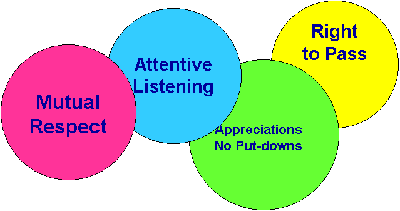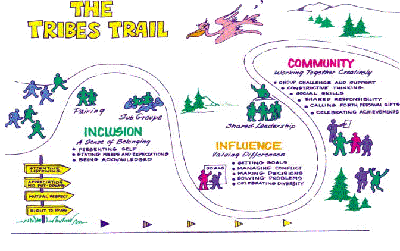Tribes began to evolve in the early 70s through the work of Jean Gibbs when concerned educators and parents were looking for ways to: motivate children’s learning improve academic achievement support classroom management and manage school behaviour keep kids in school in a safe, risk free environment.
Tribes Community Agreements
The Tribes process uses 4 agreements that are essential to building a safe and caring community for learning.

Attentive Listening
- to pay close attention to ones another’s expression of ideas, opinions and feelings
- to check for understanding
- to let others know they have been heard
Appreciation / No Put Downs
- to treat others kindly
- to state appreciation
- to avoid negative remarks, name calling, hateful gestures or behaviours
Participation /The Right to Pass
- to have the right to choose when and to what extent you will participate
- to observe quietly if not actively participating
- to choose whether to offer observations later to the group
Mutual Respect
- to affirm the value and uniqueness of each person
- to recognize and appreciate individual and cultural differences
- to offer feedback that encourages growth
The more these four agreements are internalized and enforced by students with one another the more order is maintained. Tribes is a process that provides a philosophy and framework for school restructuring.

The Tribes Trail is a map that describes the process that builds community and makes small groups work well.
A feeling of inclusion is one of the 3 key concepts of the process of Tribes. Common sense and much research tell us that students who never feel included inevitably either act out or drop out. (Not by just dropping out of school, but by not participating, not wanting to learn, remaining passive or becoming loners.)
Inclusion plus the 4 agreements:
- quickly build the sense of safety and belonging,
- use collaborative methods for group decision making and problem solving
- help members share leadership and responsibility.
The stage of community doesn’t wait until the end of the trail but rather hums along throughout ALL the stages.
The teacher leads at first to develop inclusion to establish the agreements and to structure face to face interaction.
During influence and community stages where people are working together the leader is transferring responsibility to the tribes. This develops student leadership, self direction, and individual responsibility.
Flying high above the map is a bird called “reflection”.
This signifies the practice in tribes of looking at what is going on.
Reflection is used after every learning experience where students:
- report on content learned
- report on group interaction
- report on personal learning
Reflection clears up confusion and helps everyone soar to greater heights.
All living, work, and play take place in groups of people. By integrating academic content into the strategy format of Tribes, teachers are able to promote both intellectual and social learning at the same time.
A Shared Mission and Goal
The mission of Tribes is to assure the healthy development of every child so that each has the knowledge, skills and resiliency to be successful in a rapidly changing world.
The goal for a Tribes school is to engage all teachers, administrators, students and families in working together as a learning community dedicated to caring and support, active participation, positive expectations for all students.